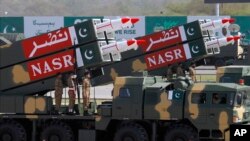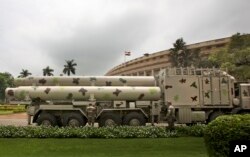India and Pakistan have fought three wars and have been on the brink of another several times, a worrying prospect given that both have growing stockpiles of nuclear weapons and questions about how secure they are.
The arms race between the South Asian neighbors has moved to enhancing the delivery systems for the warheads, which could annihilate the subcontinent several times. India's recent launch of more than 100 satellites with a single rocket foreshadows the capability of sending up a missile with multiple nuclear weapons.
The volatility of the situation is further exacerbated because neither country has a national missile defense system, and it likely would take several years to get one in place.
While the policy of mutually assured destruction has kept hostilities from overheating so far, experts believe that a misunderstanding or misadventure could escalate to a full-fledged war with nuclear weapons in play.
And there are plenty of risks.
Kashmir a flashpoint
Kashmir has been a flashpoint since the subcontinent was partitioned in 1947 and caused the most recent flare-up last November. Both sides accuse each other of harboring terrorists who launch cross-border attacks. Therefore, the question is whether the nukes in South Asia could fall into the wrong hands during mobilization in the fog of war.
Nuclear arms experts Hans Kristensen and Robert Norris estimate that Pakistan has 120-130 nuclear warheads compared with India's 110-120. India is said to have a stockpile of 540 kilograms of weapons grade plutonium, enough to produce 130 warheads. Pakistan has 3,100 kilograms of highly enriched uranium, sufficient to build 300 warheads. That's a lot to keep an eye on.
“The nukes were safe when these were in storage areas in both countries,” Michael Krepon, co-founder and senior associate at Stimson Center, said in an interview with VOA's Urdu Service. “But when these have to be moved around in a state of war, it surely raises a red flag about their security on many counts.
Serious concerns
“The biggest concern was about Pakistan's tactical weapons, which have a very short range,” Krepon said. “It means that these will have to be moved very close to the battlefield. There are fears that independent groups who want to settle scores with either Pakistan or India could attack them.
“Secondly, these could be attacked by Indian warplanes. Thirdly, since the fissile material has to be transported separately to combine with the main structure, this fissile material could also come under attack. These factors pose greater concerns, especially in the United States.”
Professor Scott Sagan of Stanford University adds: “The plausible place to move these tactical nuclear weapons would be to roads where these would be less vulnerable to Indian attack due to their flexibility. However, this also generates a fear that these could become vulnerable to terrorists' seizure in whole or in part. The same was true for India.”
The countries have continued to expand their nuclear capacity long past the stated goal of a “credible deterrence” the vow of no first use. “No first use policy in India was a misnomer, and India would opt for the first strike if it deemed necessary,” said Mueed Yousuf of the United States Institute for Peace.
Professor Paul Kapoor of the U.S. Naval Postgraduate School added: “If India used nuclear weapons, it would use them in massive way to inflict an unacceptable harm to adverse countries.”
A two-pronged policy
Zamir Akram, a former Pakistani ambassador and U.N. representative, said Pakistan's nuclear doctrine initially was based on India's much larger superiority in conventional weapons. However, in response to India's “Cold Start” doctrine, allowing it to attack Pakistan with conventional weapons to prevent nuclear retaliation, Pakistan changed its policy of minimum credible deterrence to full spectrum response with tactical weapons armed with low-grade nuclear material for use in the battlefield, Akram said.
Kapoor says that results in a two-pronged policy: use low-grade tactical nuclear weapons in a conventional war, and use nuclear weapons in case of an imminent nuclear attack by India.
“While Pakistan had a bigger stockpile of nukes as compared to India, the induction of very short-range tactical weapons into its conventional warfare mechanism was a worrying factor,” Krepon said.
India developed its first strategic ballistic missile in 1996 with a range of 250 kilometers. During the last decade, it has added medium- and long-range missiles that can reach Pakistan and China.
Pakistan has missiles capable of carrying conventional and nuclear warheads up to 2,750 kilometers, enough to target all major Indian cities, and cruise missiles capable of carrying nuclear warheads.











